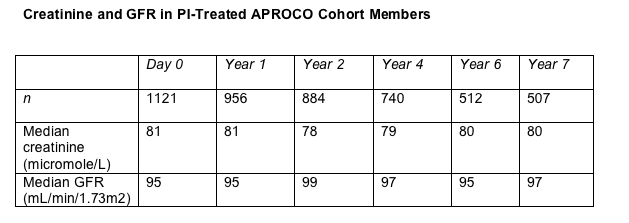 |
 |
 |
| |
Long-Term Kidney Damage From Indinavir But Not Tenofovir
|
| |
| |
11th European AIDS Conference
October 24-27, 2007
Madrid
Mark Mascolini
French APROCO cohort members who took indinavir in the early triple-therapy era suffered a setback in renal function that they never erased through 7 years of follow-up [1]. But tenofovir had no detectable impact on the kidneys in this 1121-person study.
For 7 years Francois Raffi and APROCO cohort coworkers monitored 1121 people who began a protease inhibitor (PI) regimen from 1997 through 1999. They tracked kidney function by measuring creatinine and calculating glomerular filtration rate (GFR) with the MDRD method. The study group was 77% male and 11% non-French. Median age at cohort entry stood at 36.5 years, and 21% had AIDS.
v
Median body mass index edged up from 22.0 kg/m2 at cohort entry to 22.7 kg/m2 after 7 years, while median CD4 count vaulted from 273 to 524 and median viral load dropped from 4.5 to 1.7 log copies/mL. At the end of follow-up 198 people (18%) had hypertension.
At cohort entry median GFR was significantly higher in males (+10.06 mL/min/1.73m2) younger people, people from sub-Saharan Africa or French overseas areas (+18.65 mL/min/1.73m2), injecting drug users (+6.03 mL/min/1.73m2), and people with a body mass index below 19 kg/m2 versus 25 or more kg/m2 (+9.59 mL/min/1.73m2). GFR was significantly lower in people with a CD4 count below 50 (-2.93 mL/min/1.73m2) or from 50 to 200 (-5.28 mL/min/1.73m2) versus 350 or higher.
Neither creatinine nor MDRD-measured GFR varied much through 7 years of follow-up (Table).

In the first 16 months of follow-up, female gender, an AIDS diagnosis, higher body mass index, and indinavir use correlated with a falling GFR slope. After 16 months of follow-up, only coming from sub-Saharan Africa or a French overseas area correlated with a declining GFR slope. Tenofovir therapy had no impact on GFR slope before or after 16 months of follow-up. The APROCO team counted 532 people (47.5%) who took indinavir for a median 21.1 months and 214 (19.1%) who took tenofovir for a median of 20 months.
Improving GFR during the first 16 months of PI therapy may reflect treatment's beneficial effect on renal function, Raffi and colleagues speculate. Indinavir apparently hampered this improvement in the early days of triple therapy, and that deficit remained detectable through 7 years of follow-up, even though most people stopped taking this PI. The APROCO investigators recommend continued close monitoring of GFR in people who took indinavir.
Reference
1. Raffi F, Rossert J, Pereira E, et al. Determinants of alteration of renal function in an observational cohort of treated HIV-infected patients: 7-year follow-up (ANRS CO8 PROCO-COPILOTE). 11th European AIDS Conference. October 24-27, 2007. Madrid. Abstract P9.7/03.
|
| |
|
 |
 |
|
|